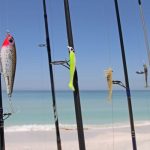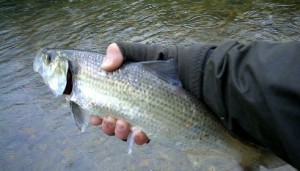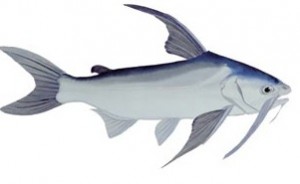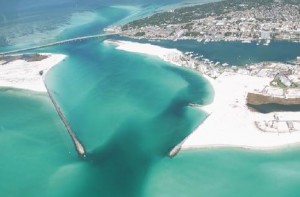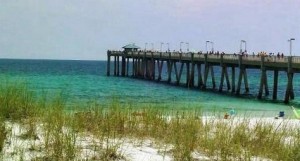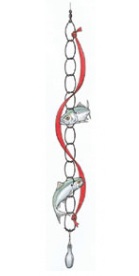A Lifetime Love of Fishing and the Sea
The deep and mystical allure of fishing has been with me since I can remember. I’ve loved the mere presence of the ocean — I could stare at for hours, and be nurtured by it, and calmed by it. And as I watch it form the sore, or a balcony, or a bridge, I’m always tantalized by the possibility that at any moment I might see something — a dolphin surfacing, a pelican diving, baitfish chopping up the surface as something larger chases them beneath the surface. It’s calming and exciting at the same time — and never boring. My one constant dream since early childhood is to one day live “on the water”, with a daily view of all of the beauty and changeability and abundance that the sea represents for me.
BEGINNINGS
It began on a trip to visit relatives at the Jersey Shore when I was 4. Somehow it evolved that we got to go out deep sea fishing and from that day on — even though all we caught was a blowfish of all things — I was hooked. There is a grainy black and white photo of me that say, sitting at the rail of the boat, life-jacket on, looking as serious as a surgeon, vaguely irritated that someone is bothering me to take a picture. Although I can’t remember what exactly was going through my mind at that moment, my reading of the picture is that I was irritated that someone was interrupting the serious business of minding my line in the water for something as frivolous as a photograph.
We lived in Washington, DC in those days, and after the trip to the Jersey shore I began to pester my father–a no-nonsense Army officer who had never fished in his life– to take me fishing on the Potomac, where each year the running of the shad would turn the muddy river near Fletcher’s Landing into a fisherman’s paradise–one where skilled anglers brought bushel baskets to carry home their catch. He tried to ignore me at first — but I was focused, and persistent — and I wouldn’t be ignored. So with some cajoling from my mom, he eventually relented and, armed with cheap spin-casting rods and reels bought at the nearby Sears store, and not having a clue what to do, we began making weekend pilgrimmages down to Fletcher’s Landing where we would muscle in among the hundreds of other fisherman and watch them catch basketloads of shad, while we inevitably would go home empty handed. I was troubled by our lack of success — it was the first time I had seen my father, so accomplished at everything else he did, fall short in any endeavor. It was the first time I sensed that even a Dad couldn’t always prevail.
SHAD FISHING ON THE POTOMAC
To get to Fletcher’s Landing we had to park out on River Road and then hike in through rocky pools where bow fisherman were busy trying to shoot big catfish that lurked in the pools. I was fascinated by this — but my Dad kept me moving. At Fletcher’s landing we would rent a small rowboat and joint the dozens of others out on the river. Shad fishing during the Potomac run was unusual in that the preferred method was simply to put three treble hooks on a leader with a sinker at the bottom and toss it into the river and jerk, snagging the shad that were so plentiful that, for the experts, a fish would likely be taken every two or three casts. Lures and jigs were also used . We were anything but experts, however, and all we could do was watch helplessly as others took home the fish.
One day, I remember a moment of great excitement as I saw my father pull in his first fish — a small catfish six or seven inches long. But there was a “catch” to the catch: The catfish already had a hook in its mouth and a gnarly of fouled monafilament line trailing from the hook. My dad, in his efforts to snatch a shad, had snatched the monofilament bird’s nest handing from the mouth of the catfish. Did this count as a catch? We decided not, and removed the hook and released the catfish back into the river.
On our fourth or fifth trip, we wanted off the main river onto a small tributary and there, fishing with worms from the rocks, we hit paydirt. I still remember the moment when my Dad first reeled in a shimmery, dancing shad–not a big one, to be sure–but a shad. And soon I had one, and another, and another. We didn’t have a stringer with us (hadn’t occurred to us we might actually catch fish), so we found a plastic bag and put them in that, then once ag the car my dad washed out an oil pan he had in the trunk and we put the fish in that. The next thing I remember is walking proudly through the door of our house, holding the oil pan full of shad and a few catfish. My mom was on the phone telling someone how we had gone fishing and she was sure we’d be coming home empty handed again — only to see her proud 4 year old walk through the door holding a decent sized mess of undersized panfish. None of us knew how to clean them, but somehow we managed and that night ate our first meal of family-caught fish. There were more bones than meat — but it didn’t matter, they were the best tasting fish my four year old palate had ever tasted.
Here’s a video that gives a good view of shad fishingon the Potomoac at Fletcher’s Cove:
SAILCATS IN THE CHOCTAWHATCHEE BAY
The summer between first a second grade we moved from Washington to our hometown of Greenville, Alabama, where my mom, my sister Valerie and I would spend the next year living with my grandmother while my father served what the military called a “hardship tour” — a one year assignment to Korea without the family. But before he went, we took the first trip to the place that would become almost sacred to me–Villa Tasso, on the Choctawhatchee Bay near Destin, Florida, to the home of my Aunt Caroline and Uncle Arthur Wagner. Their house was an old rambling two story settled amidst spanish moss covered trees, right no the banks of the bay. A thirty foot embankment led down to a narrow beach. A long shallow shelf of amber hued water thrust out for half a mile, where there was a dropoff and blue water abruptly began. A sandy road ran along the bluffs n front of the house — a road so infrequently traveled that the better part of a day could go by without a vehicle passing by. There were a dozen or so houses and a few house trailers in the settlement, populated by natives who called themselves “fish heads”. There was a small clapboard cottage on the grounds of Uncle Arthur’s house, and it was here that we set up housekeeping for a two week vacation that would be the grandest fishing frenzy of my young life.
One of the neighbors, a silver haired “man’s man” named Paul Cannon, had an aluminum rowboat which he loaned to me and my father. (My Dad was only impressed by two men that I know of in his life — Paul was one, that’s why I call him a “man’s man.) Blessed with the free use of Paul Cannon’s boat, as soon as it was daylight we would go down to the beach, where the early morning waters were still, calm, and clear. In the amber shallows we would wade, then place a one yard square lift net on the bottom. We would sprinkle bread into the water aboard the net and within a few seconds minnows would converge on the bread. My father would wait until there were plenty of minnows — then heave the net up and out of the water, catching dozens of flashing silver minnows with each effort. During the first few days we tried to keep the minnows alive in a bucket we placed in the boat.
I still remember the first day — I think my Dad was a bit nervous because he’d never handled a boat before, so we stayed in the shallows, fishing with live minnows. I caught a decent sized sea catfish, but the award for excitement went to my father who hooked and landed a dancing three pound ladyfish that jumped spectacularly a half dozen times before he got her into the boat. We went home with the catfish and ladyfish (which the locals called “skipjack” even though it is basically a scaled down tarpon, and has no relationship to skipjack tuna at all).
On subsequent days we ventured out past the blue line and there we found the fish that would define that trip and provide some of the most glorious fishing of my life — “sailcats”, or more properly, “gafftopsail catfish”. Now I realize that catfish are generally not considered remotely “glorious”, but these were different. The were a spectacular shade of grey-blue with a six inch long dorsal fin and pure white underbellies–2-4 pounds each, capable of putting up a good fight and absolutely delicious to eat.
The second day, as we began catching the sailcats, we brought home half a dozen or so which at the time I thought was the ultimate stringer of fish that anyone coudl aspire too. I proudly carried it up the embankment to the cottage, barely able to keep my balance (the stringer weighed about 15 pounds, and I weighed about 50).
As the days progressed we got better and better at catching the sailcats. A major discovery–the deader and smellier the bait, the better the fishing was. So we stopped trying to keep the minnows alive, and even took to pinching off their heads so their entrails would ooze out into the water–which the sailcats loved.
Partway through my “two weeks in heaven”, Paul Cannon came up with a tiny trolling motor which he and my dad worked on for sweveral nights until they got it working, then they attached it to the rowboat. This brought about some changes to our setup — I moved to the front of the boat, and my Dad stayed in the back to manage the motor as we puttered through the bay. On the first morning we had the motor, we found ourselves in the midst of sailcat madness. We had found a spot where they seemed to be bedding — and with the trolling motor it was possible to drift fish across the bed, then re-position for another pass. Each pass yielded 3-4 fish, and we soon had a stringer that must have weighed 75 pounds. I was so proud of that stringer of fish I almost couldn’t contain myself. I could imagine dragging it up the embankment, then washing the sand off with a hose before presenting the massive trophy to my mom and sister. The only catch was — each time we repositioned my father had to hand the string to me in the front of the boat so that it wouldn’t get fouled in the propeller. Then, with 25 fish (at least) on the stringer, we were just about ready to go in when my father forgot to hand the stringer forward to me before starting the engine. In an instant the propeller had cut the stringer and all but a few whose heads managed to get in the way of the propeller got away. Aside from it being time for lunch, we were also out of bait — so we went home empty handed and instead of triumphantly carrying a 75 pound stringer of fish up the embankment, I just ran up the embankment and flung myself into bed, sobbing. Later my mom would tell me that my Dad’s comment was that he, too, felt like crawling into bed and crying.
That vacation finally came to an end — but not before that old rambling house and adjacent cottage on the Choctawhatchee Bay had become the spiritual center of my universe — a place to which I would return again and again, and to which I still return today, where Uncle Arthur and Aunt Caroline, now in their nineties, still live. It’s the one piece of permanence in a life that has taken me around the world many times over — the one place from my childhood that’s still there, with the same people — the same simple beauty — nothing has changed.
CANE POLE FISHING IN SOUTH ALABAMA
In Greenville that year, while my father was in Korea, I learned to fish for bream and bass using live worms and a cane pole with a bobber. The cane poles were long — 10-12 feet, and you would simply tie to the line to the end of the pole and flip the bobber with worm attached out into the water and wait. I was a patient fisherman even as a seven year old — could watch that bobber as long as necessary waiting for the excitement of a nibble that would make the bobber dance — then suddenly disappear beneath the surface.
Every week or two we would go out to Sherling Lake, a public lake on the outskirts of Greenville, and my mom, my sister Valerie and I would fish for a few hours. I kept a leaf pile in the backyard of the house so that I could harvest my own worms for bait — although I do remember buying worms a few times. Usually we caught a decent mess of panfish — bream and bluegill mostly. And there was the occasional bass.
More exciting were the visits to my Aunt Sadie’s house outside of Greenville. She had the most amazing thing — a fish pond in her backyard! Sadie was one cool lady. I remember watching in awe as she expertly cast her spinning rig into the pond and pulled out bass after bass, while I struggled along the shore to catch panfish. If I could have lived with her I would have been in heaven.
LEARNING TO FISH THE CRYSTAL BEACH PIER, DESTIN, FLORIDA
Eventually the long year with my dad in Korea was over and he returned — and when he did, our first move was to return to Villa Tasso and the cottage at my Uncle Arthur’s house. This time, however, we were after bigger game. Directly across the bay — 6 miles as the crow flies but 40 miles by car around the bay — was the famous fishing town of Destin. Unlike the other beachfront towns like Fort Walton, Panama City, and Pensacola — all of which catered to the general tourist crowd — Destin was known for one thing and one thing only, and that was fishing. The approach to Destin meant crossing the Destin East Pass which, at high tide on a sunny day is possibly the most beautiful body of water I’ve ever seen to this day — and to my 10 year old eyes it was breathtaking in the extreme or — in the words of my Dad — “flat out spectacular”.
A sign on the Fort Walton side of the bridge proclaimed that Destin was “The Luckiest Little Fishing Village in the World”, and I certainly believed it. After crossing the East Pass it was only a few blocks past the harbor and the Donut Hole and the Destin Diner — then we were out of town and headed on toward Crystal Beach. Along the way to Crystal Beach, the town gave way to open dunes, and I could see the truly spectacular waters of the gulf through the dunes — and I think it was at this time, when I was 10, and when we drove this route every day for two weeks — that I reached some kind of inner conclusion that the water and dunes of Destin was the piece of natural beauty by which all other natural beauty would be judged in my life. And guess what — almost 50 years later I’ve yet to see anything that beats it. I think this is in large part because of the picturesque nature of it — but more than that, it is the life that abounds. There are birds everywhere, tiny fish in the shallows, larger fish and dolphins farther out — so that each peak between the dunes would be more than a glance at natural beauty, it would be a quest for spectacular wildlife nestled into that natural setting.
By now my father was as avid a fisherman as I was, and given that we couldn’t afford a boat of our own or even a charter — there was only one place to try for the big ones and have a real chance of getting them, and that was at the 650 foot long Crystal Beach Pier. You had the sense in those days that Crystal Beach was well outside of Destin — even though today if you go there, first of all the only thing that’s left is a few of the pilings poking through the water, and secondly the modern sprawl of Desitin makes it feel like Crystal beach is part of the town, rather than a solitary outpost among the dunes as it seemed to be in those days.
Sadly, the pier underwent a decline over the years, with various hurricanes damaging it and shortening it. Finally in the late 1990’s it was taken down, but pilings still remain in the water and although the atmosphere has changed, it’s still a magical place where a tremendous number of dreams were fufilled — mine among them.
Gene Burnett owned the Crystal Beach Pier. His son, Terry Burnett, was a year or two older than me — but half my size — and a local star already because in 1960, at the age of 11 and 3’11” tall and weighing 51 pounds, Terry had famously caught a 500 pound shark off the pier using a casting reel with 200 yards of 50lb test line. A picture of Terry and his catch had appeared in Sports Illustrated, and Terry himself had been on To Tell The Truth. I felt his celebrity status was well deserved — but was sure I could’ve done the same thing if given a chance, which I guess means I was a bit jealous.
Unlike the amber waters of the bay — here, on the Gulf of Mexico, the sand was as white as sugar and the water a spectacular gimlet green in the shallows, growing darker as it moved offshore. Where the pier ended it was a deep emerald — but seventy yards or so from the end of the pier, just within reach of a long cast — the water turned bright geen again at the offshore sandbar when the water was only 10 feet deep.
Fishing on the pier was a dream for me. We went every summer when I was 8, 9, and 10. We accumulated large spinning rods capable of fishing for the “big’uns” — bonito, king mackerel, an occasional tarpon. And smaller rigs for catching baitfish which were locally known as “L Y” (I’m not sure about the spelling. I think the actual fish is properly called an “alewife”, a type of small shad.). I also used the baitfish rigs to fish for tasty pompano and inedible but fun-to-catch hardtail.
One of the most alluring aspects of pier fishing in Destin was that for the most part it was “sight fishing” — meaning, you could see the fish you were trying to catch in the clear green water. Starting with the baitfish, which would gather together in a tight ball that looked like a cloud in the water.The baitfish rig was peculiar — you could either “snatch” them using treble hooks, or if you wanted to catch “el-wy’s” without harming them you used a “ribbon rig” — a series of wire hoops with a ribbon draped through them, no hook at all. You would drop the ribbon rig into a cloud of baitfish and wait for them to start attacking it –pretty soon one (or two would get entangled in the hoops, then you’d pull them up, trop them into a life wait basket which you’d then drop back into the water where they could be kept indefinitely.
Catching the baitfish was fun enough for a 10 years — but the real fun was going out to the end of the pier with a life “L Y” attached to a hook with steel leader. You’d dangle the live bait in the water out towards the submerged sand bar, waiting. Suddenly someone would shout out “bonito!” or “king”, and there would be a flurry of activity as everyone with similar sight fishing rig would reel up their bait, then cast frantically at the dark shapes of a group of marauding bonito or king mackerel. Lines would get snared, tempers frayed — but with each flurry someone would usually hook up, and the rest would reel in and wait for the next sighting while the lucky fisherman with the king mackerel or bonito on the line would work the fish for the 10-15 minutes it would take to land.
As a 10 year old I was suspect when it came to trying to join the big boys going after king and bonito, and would even come in for some abuse every now and then from someone feeling I wasn’t old enough to be out at the end of the pier elbowing my way into the action. But I knew what I was doing and my Dad was there to stand up for me when needed. And I caught my share of the big ones — loving every minute of it.
We would leave every morning before daylight to make the long drive around the bay, arriving at the pier before 7 and paying the $1.50 (adult) and $.75 (child) to get our hand stamped and head out to heaven. Although I spent most of my time at the end of the pier sight fishing for bonito and king mackerel, I would occasionally succumb to the lesser thrill of taking the bait fishing rig and putting a yellow “dude” on it and go down to the shallows in search of pompano. These were somewhat elusive — and there was a certain culture of the pompano fishermen, most of whom never ventured out to the end of the pier. The flesh of the pompano was held in great regard, and for good reason — indeed as far as the “fishing for food” crowd was concerned, pompan0 was “the” fish to be fishing for.
The other fish that could be a bit of fun, although they were considered to be inedible (very bloody), were “hardtail”, a species of small jack that would hang around the pier and strike at either live bait of a white dude (never yellow, that was for pompano). Hardtail fought hard for their size, and sometimes were so abundant that you could just wear yourself out dragging them in. (I found this 30 second Youtube clip of people pulling in hardtail, frequently two or three at a time, using multi-hook bait rigs. It gives you a sense of how lively even this kind of ‘goofing off’ fishing could be.)
GALVESTON AND FREEPORT
When my father returned from Korea, we moved to Houston, Texas, where he was assigned as an ROTC instructor at Rice University. By now he and I had both been bitten so fully by the fishing bug that nothing would do but to get a boat so that we could fish off Galveston and Freeport. It took a while, though — money was tight, so at the beginning we make the 50 mile drive to Galveston and do jetty fishing. Although Galveston Beach has many charms — the beach itself didn’t compare to Destin. The sand was dark and the shallow water shelf was much like the Choctawhatchee bay — producing brown water rather than the crystal green water of Destin. But it was water, and there were fish. I remember the first jetty fishing day it was very rough and we got sprayed with water constantly for half a day, during which we caught one whiting. Other trips were more successful. And the finally, miraculously, my dad put the money together and got a boat — I couldn’t believe it, a boat! A fourteen runabout with a Mercury outboard that could push us along at a good clip. We would go every weekend, dragging the boat behind us — cast fishing in the Gulf of Mexico for Spanish Mackerel, or bottom fishing for snapper and grouper.
THE SUMMER OF THE BOAT IN DESTIN
By the time I was eleven we were scheduled to leave Houston and move to Germany — a move which distressed me not because Germany was overseas, but because it was basically landlocked and fishing was complicated, according to what we heard. But before we went, we were going to have a glorious vacation, staying in a rented apartment on the bay where there was a dock and where we would have our own boat for the first time. I couldn’t wait. Every day for a week my Dad and I would go out in the outboard and just follow the charter boats to the offshore fishing grounds, where we’d troll and match our catch of king mackerel and bonito to those of the charter boats. Every day but one was successful and that one was the last day — a day when we didn’t catch many fish — but a day that may be the most memorable day every on the water for me.
The water was flat calm, and the sun was high — the color of the water in close to shore was just breathtakingly green with a sparkle to it that took my breath away. We decided to go in close to shore, with no particular expectation of catching fish — just wanting to enjoy the beauty of it all. The water was so calm there were people water-skiing in the gulf — something I’ve never seen before or since. We eventually stopped fishing and just ran the boat along the coast through the dazzling water. I sat on the front of the boat, watching the water rush beneath me, able to see the bottom clearly and feeling as spiritually refreshed and complete as I have ever felt before or since. We ran for 10 or more miles along the coast an then for good measure, took the boat in through the Destin East Pass where was high tide, and where the clear green water extended beyond the bridge, into the bay — creating emerald clarity in the bay itself . And it was there, as we were running along at twenty miles an hour inside the bay, with me on the bow looking down into the clear waters, that without warning I saw a site that has stayed with me for almost half a century — a mother dolphin with a young calf, swimming almost as fast as we were. They stayed underwater for a good minute or two, keeping pace with us — then surfaced, first the mother, then the calf. They ran along on our bow wave for a a few minutes, then disappeared. I never said anything — neither did my dad. We just watched them, and they watched us. Then we headed home.
Year of the Spy Book Trailer
Above is the Year of the Spy Book Trailer — for my upcoming non-fiction book about espionage upheavals on the streets of Moscow in 1985.
Below is a “trailer” showcasing the writing and video services I provide to clients.
Michael Sellers — Writing and Video Services
My eBook — Just released Dec 5, 2012
EBook You don't need a Kindle or iPad -- Download Adobe Digital Editions for Free, then read the .mobi (Kindle Format) or .epub (Nook, iPad Format) digital book on your computer. Or order the PDF which is formatted exactly like the print book.Recent Posts
- Arsha Sellers — Today I’m One Big Step Closer to Becoming a Real Forever Dad
- Meet Abby Sellers and Arshavin Sellers — My Wife, My Son, My Inspiration Every Day
- What the Mueller Report Actually Says
- Remembering James Blount, an American Who “Got” the Philippines in 1901
- America the Beautiful? You Mean America the Pitiful. I Am Ashamed

